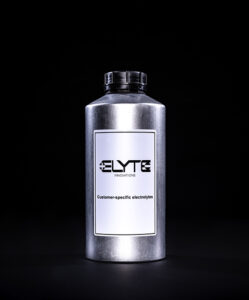
Electrolytes for smart glass
Smart glasses, also referred to as “intelligent” glasses, are innovative glass products that can change their optical properties to respond to different stimuli or inputs. These glasses use special technologies to adjust their transparency, light transmission, or other properties as needed. To achieve these effects, electrolyte solutions with special characteristics are needed. E-Lyte develops and produces perfectly fitting electrolytes for smart glass.
The technologies behind smart glasses can be electrochromic, switchable, thermochromic or other materials and mechanisms to achieve the desired effects.
E-Lyte provides its high-performance electrolytes mostly for electrochromic glasses.
Electrolytes for electrochromic glassSuitability of liquid electrolytes from E-Lyte for smart glasses!
Basically, liquid electrolytes are useful in smart glasses when electrical charges need to be transferred to control the optical properties of the glass. Choosing the right liquid electrolyte depends on the specific requirements of the application. E-Lyte offers its customers the perfectly fitting electrolyte formulation for electrochromic glass in the highest quality!
Electrochromic glass is a special glass that can change its light transmission with the help of applied electrical voltage. The electrolyte plays a crucial role in this process. The electrolyte is introduced between the two layers of glass and performs two important tasks:
- Ion transport: When an electrical voltage is applied to the electrochromic glass, the electrolyte enables the transport of ions between the glass layers. Generally, these are positively charged cations and negatively charged anions. These ions move through the electrolyte and reach the electrochromic layers on the glass.
- Electrochemical reactions: The electrochromic layers are made of materials that change their optical properties when they come into contact with ions. The ions from the electrolyte trigger electrochemical reactions in the electrochromic layers. These reactions lead to changes in the light transmission of the glass – it can become cloudy or lighter, depending on whether ions enter or migrate out of the electrochromic layers.
By controlling ion transport and electrochemical reactions using the electrolyte, electrochromic glass can adjust its light transmission, regulating the intensity of incident light or visibility through the glass. This finds application in areas such as smart windows, automotive glazing, and other applications where dynamic control over light transmission is desired.
Working principle of electrochromic glass
Electrochromic glass, an innovative advancement in the field of active smart glass, is manufactured by incorporating an electrochromic layer between layers of glass and conductive materials. Its operational principle involves the controlled application of an electric current, thereby prompting the activation of ions present within the electrolyte layer. This orchestrated ion movement leads to a notable transformation within the electrochromic layer, resulting in a transition from a deep coloration to a state of high transparency.
Unlike conventional smart glass, electrochromic smart glass presents a distinctive characteristic: a default state of transparency. It preserves a visually clear state until an electrical stimulus is applied, instigating a well-defined shift to an opaque state.
The convergence of technological prowess and intricate design in electrochromic glass holds considerable potential. This innovation finds utility across diverse domains, ranging from architectural applications, where natural light and privacy can be controlled via a controlled mechanism, to energy-efficient solutions that dynamically adapt to external environmental conditions.
